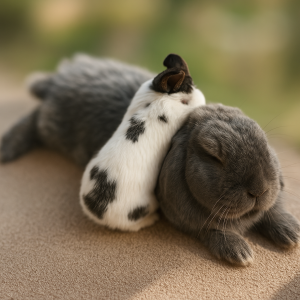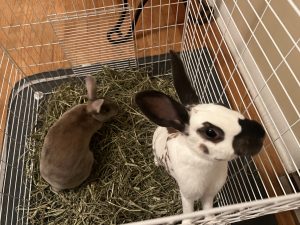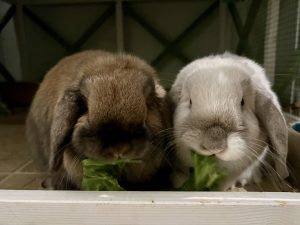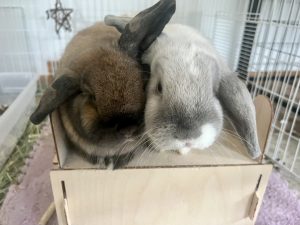Importance of Bonding
Rabbits are social animals who crave daily and constant interactions with companions. In the wild you would rarely find a rabbit alone. To mimic their natural behavior, it is a good idea to keep your pet rabbit with a friend to avoid them feeling lonely and unhappy.
You may play with your rabbit when you are home, but who does he/she snuggle with while you are at work or asleep? A single rabbit may get depressed. Rabbit couples spend much of their time together playing and exploring together, laying together, and grooming each other. No matter how much we spoil our rabbit(s), a rabbit friend helps them feel more relaxed and happy.
Finding a Companion
Working with an organization that fosters rabbits is your best option to try finding the right companion(s) because they get to know their rabbits’ personalities. A good organization will try to match rabbits based on personalities. Bonding is never a for sure thing, but we at Oscar’s Rabbit Rescue (ORR) try to help make this work by suggesting likely companions based on temperament and interests.
Although it is not impossible to bond same sex rabbits, opposite sex bonds typically work best.
Size and breed does not matter.
Age may or may not have an effect on bonding. A rabbit’s true personality does not really start to show until 6-8 months of age if they have already been spayed/neutered. Around 18 months of age a rabbit will start to calm down a little and settle into their own personality. Personalities are also effected by environments and health. Read more about ages & stages here.
The Basics for Successful Bonding
- Both/all bunnies must be altered (spay/neuter).
– Hormones cause chaos and hormonal frustrations for the rabbits. You may see increased fighting, territory issues, urine spraying, and overall more aggression.
– We frequently see accidental litters due to wrong sexing. Rescues/shelters are already overloaded. Don’t add to this!
– After surgery, it is best to wait for hormones to neutralize out. Additionally, males can still impregnate a female for up to 3 weeks after being neutered. It is ideal to wait at least 4 weeks to attempt bonding, but some rabbits may need up to 8 weeks for hormones to settle down. During that time you may see “hormonal rages.”
- Patience is of great importance.
– Some bonds happen quickly while others can take several months. A bond is on the rabbits timeframe, not yours. Do not rush this.
– Slow progression: Start with putting pens close to each other. Do not allow their pens to touch until there is no fighting.
– Rabbits can sense human moods/feelings. Avoid being stressed as it will cause the rabbits to be stressed which may results in rejected each other. Set aside your emotions during bonding. Your rabbit(s) will not love you any less after forming rabbit bonds.
- Flexibility. Rabbits can be particular and stubborn about their companion. If you are insistent on matching your rabbits based on specific breed, size, or looks you may be disappointed. A rabbit has no bias on this. What is important is personalities For example, do not try to bond 2 sassy or territorial rabbits. More appropriate is a submissive rabbit with a this type of personality.
- Bonding location and set up:
– Neutral territory must be used when attempting to bond.
– Provide a closure that they can see through so they don’t feel trapped. This space must be large enough for the rabbits to be able to move and lay down in but small enough that they cannot run at each other.
– Remove all extra stressors from the room (e.g., dogs, smells of other rabbits, etc.).
– Provide a non-slip base covered with hay. It may also be helpful to hide pellets/veggies throughout it to give some distraction from each other. Eating together can also help with bonding if neither rabbit is territorial about food.
– Never let a loose rabbit come in contact with a caged rabbit. This encourages aggression.
- Safety:
– To prevent personal injury, wear thick gloves and separate immediately if a fight starts.
– Prevent injuries and promptly seek vet care if there are injuries. Bites and open wounds frequently turn into infected abscesses.
– Keep sessions short and slowly increase timing of them when positive signs of bonding are seen.
- Ending on a positive note:
– End sessions before tension rises.
– Bunnies have amazing memories and will not forget. They will also quickly learn that negative behaviors get them out of the situation when you remove them. If an altercation happens and it’s not too dangerous, try to calm each rabbit down by petting them until each is calm prior to removing them from the bonding pen.
Bonding Sessions
Separate when there are signs of dislike for each other include boxing and growling. Avoid “bunny tornadoes” which looks like chasing each other in a circle.
Beginning Stages
After the rabbits have been given time to be safely near each other, start placing them together in a neutral, stress free environment for brief amounts of time. Initial bonding sessions typically only last around 15 minutes. Beyond that the bunnies get stressed out and irritable and tend to snap at each other.
Very seldomly will you see “love at first sight.” Typically, the rabbits will initially ignore each other. They tune into each others’ movements and their rabbit specific body language. They may chase and mount each other to show excitement or dominance. General humping is okay most of the time as they are still trying to figure out dominance, however, do not allow humping of the face.
Moving Things Along
 Bonding sessions may get longer as the rabbits tolerate each other more. Good behaviors may not last long, yet. Sometimes the main human caretaker needs to remove themselves so the rabbits can focus on each other while other times that main caretaker knows the rabbits best and can help calm them through this process with gentle pets as needed.
Bonding sessions may get longer as the rabbits tolerate each other more. Good behaviors may not last long, yet. Sometimes the main human caretaker needs to remove themselves so the rabbits can focus on each other while other times that main caretaker knows the rabbits best and can help calm them through this process with gentle pets as needed.
The rabbits may sniff and smell each other. They may continue to chase and mount each other. They may play by jumping over each other. They may enjoy eating together. Great signs of bonding progression are laying down. This shows that the rabbit laying down is relaxed. When both rabbits lay down at some point during the bonding sessions you have made great progress.
Another great bonding sign is when the rabbits continue to get along without your presence. You can do this by safely watching nearby where they cannot see you or through a camera with video.
Continue to monitor closely and try to work up to a period of 24 hours together without fighting or problems. This may mean sleeping near the bonding area.
Established Bonds & Moving In
Ultimately, an established bond is your judgement call.
A tell-tale sign of success may be grooming. When a rabbit put its head down and nose forward it is asking for grooming. Grooming each other is a great sign! This is a sign that bonding is going well and the bond will grow stronger going forward. If your rabbits are stubborn and against this, try to promote it by laying them next to each other and stroking the sides of their cheeks or putting a small dot of Petromalt or water on the forehead.
Final stages are moving the rabbits back into a larger enclosure. Neutralize scents throughout the enclosure and on washable items using vinegar spray.
After Move In
Do not rush large free-roam spaces. This can cause regression of bonding and dangerous fights. Only after rabbits are observed frequently grooming each other and laying with each other in their large enclosure is it okay to attempt observed free roaming together.
Bunny Dating through Oscar’s Rabbit Rescue
Bunny dating is taking your rabbit to meet potential companions. Here at ORR we are not opposed to this, but are not quite sure how well it works. Your rabbit is stressed from travel and the brief interactions may not be accurate. However, it may still help.
To keep all rabbits safe, there are requirements to bunny date through ORR. Vet proof is needed to show that your rabbit is fully vaccinated for RHDV-2 which is 14 days after the second vaccine when properly administered (2 doses 21 days apart) and annual booster thereafter (due 1 year from initial dose). Your rabbit cannot show any symptoms of potentially communicable diseases, such as any amounts of sneezing, eye or nasal drainage, loose stools, etc..
